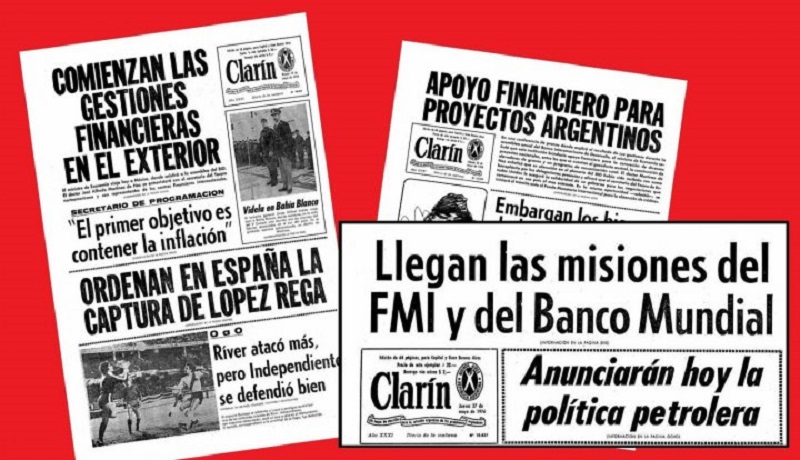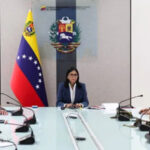
At the base of the great evils that worry us every day, such as inflationthe rise of dollar that devalues the salary, or the lack of employment with rightsthere is the enormous mortgage of the external debt.
It is common sense installed the idea that “commitments must be fulfilled”. Without going any further, the vice president Cristina Fernandez recently stated in Río Negro that “if they gave you US$45,000 million you will have to return it”, in relation to the agreement with the International Monetary Fund (IMF) that Macri signed and restructured the current government. He said this even if the loan of the macrismo with the organization did not have a social license, did not respect the minimum legal procedures (it did not even go through Congress) or the Fund’s own statute, and whose destiny was to finance the flight of capital that it benefited a handful of large companies, banks and speculators.
So who made those “commitments” and to what end? Is public debt really “everyone’s” debt, or who benefits and who ends up paying for it?
The Argentine history of debt is littered with fraudulent chapters and scams like Macri’s with the IMF, and restructuring and renegotiations (or swaps) that validated previous scams, such as those of Alberto Fernández and former economy minister Martín Guzmán.
It is that the current debt was not born from a cabbage, but is the product of a vicious process of borrowing and looting of the last five decades: the debt that Alberto Fernández restructured comes from the macrismo, the debt of the macrismo is partly a consequence of the previous debt, the debt that Nestor Kirchner restructured in 2005 and Cristina Fernández de Kirchner in 2010 is the consequence of the debt from 2001, from the mega-swap and from the shield, and that debt is the consequence of the debt from the 1990s, this in turn comes from the 1980s, and the latter from the military dictatorship.
Between 1976 and 1983 the public debt multiplied almost six timesgoing of US$ 8,085 million a USD 45,065 million. Never in history had it had, nor had it ever since, such rapid and high growth.
The debt that today suffocates and conditions the economy originated illegitimately and illegally in the last military dictatorshipwhich was imposed by blood and fire against the working class.
It was shown that the military incurred in 477 illicit with the debt. But the Olmos case was sent to Congress and then shelved by Peronists and radicals.
This fraud had 3 main chapters:
1) The very public debt that the de facto government took
The loans include one with the IMF, a few days after the start of the Coup, first for US$ 110 million, and a few months later an extension of this agreement. As Lucho Aguilar points out, “the key was not so much the amount, but the political-economic meaning it had. On the one hand, they meant support for the military government on the part of the United States and financial capital. On the other, they implied the acceptance of a revision constant by the IMF to the economic plans”.
Likewise, the then Minister of Economy, Jose Alfredo Martinez of Sicklewill have the approval of international financial capital to issue public debt bonds in “the markets”, especially in foreign currency. In 1978 the Yankee billionaire David Rockefellerat that time in charge of Chase Manhattan Bank, visited Argentina and expressed “great respect and admiration” for Martínez de Hoz, who in 1977 had carried out a “financial reform” that benefited the banks and created the conditions for the “financial bicycle “.
International organizations and international financial centers were essential for the plan to attack the working class to have economic support.
The military government not only took on debt, it also paid in excess. According to Marcelo Bonelli, in that period US$ 30,000 million were paid.
2) The embezzlement and indebtedness of public companies
The loans that were taken in the name of different public companies abroad were not used to improve public services, but rather had the objective of bringing in the dollars needed by the financial speculation scheme that they imposed Videla and Martinez of Sickle.
This embezzlement from public companies was later used as argument of supposed “inefficiencies” to advance in their privatizations. In the opinion of the debt trial in which they analyzed 15 public sector companies, including YPF, Water and Energy and Railwayspoint out that almost 82% of the external public debt comes from financial loans and basically it was not allocated to productive investment in capital goodsbut to a constant renewal of short-term loans for the provision of foreign currency.
With the dollars obtained by the government and private companies, a huge currency flightwhich was multiplied by three until reaching an indentation of USD 79,912 million.
3) The nationalization of private debts
Big companies like Socma (from Mauricio Macri’s family), Techint, Renault, Pérez Companc and many more, got enormously in debt in those years, reaching US$17 billion in 1981. These debts were not correlated with investments or productive projects, on the contrary, companies created fictitious debts to enrich themselves.
These operations include important banking entities, such as the Citibank, Tornquist Bank, Quilmes Bank, French Bank, Río de la Plata Bank and some even appear in their double condition of creditors and debtors at the same time.
But when the financial scam ended, in 1982 Javier Milei’s idol, Domingo Cavallowho was in front of the Banco Centralliterally he nationalized their private debts.
Marcelo Bonelli explains in the book “A country in debt” (2004), that in many cases there is not even a record that the companies have returned the debt capital to the state, even with the liquidation of the debts that the “insurance of change” of Cavallo with which they benefited. Justice later determined that half of the debt left by the dictatorship had been private.
Break the vicious circle of debt
From the dictatorship onwards, all governments took it upon themselves to validate this fraud., through successive exchanges and restructurings. He Plan Baker and the Plan Brady in the 1980s and 1990s, they constituted debt renegotiations that facilitated neoliberal policies and the dispossession of public assets through privatizations at “caring prices”.
He “armor” in 2000 and the “megacanje” by Domingo Cavallo in 2001 are suspected of fraud with the collaboration of the IMF, the World Bank and private banks. With the “mega swap” the public debt increased by US$ 53 billion. In 2001, the IMF outlays that followed “zero deficit” almost all evaporated in capital flight.
The illegal operations were already hidden by others through the successive exchanges of papers since then. Each debt renegotiation acts as a “clean slate” to hide previous frauds.
Then came the Kircherism swaps of 2005 and 2010 which were presented as supposedly “removals” but ended up benefiting speculators with juicy clauses tied to GDP growth and the extension of jurisdiction in foreign courts. The agreement of Axel Kicillof with the Paris Club in 2014, the debt with that agency increased by more than 50% (from US$ 6,000 million to US$ 9,700 million) without providing any supporting documentation, the details are secret.
The indebtedness of Mauricio Macri it included business with friendly banks and businessmen; as the most scandalous 100 year bondthe longest in Argentine history, to favor the same Secretary of Finance, louis caputo, which was on both sides of the counter, until the agreement with the IMF that was renegotiated at least 2 times, allowed the rescue of private creditors and capital flight and broke even the statutes of the organization. This cycle of indebtedness would not have been possible without the support of peronism in Congress, which voted a law in 2016 for payment to vulture funds and then contributed votes for successive national budgets.
Con Alberto Fernandez the chapter of the validation of the scam through Guzmán’s debt swaps with private bondholders in the middle of the 2020 pandemic year, and then the debt restructuring in March 2022, precisely prior to a new anniversary of the genocidal coup. In the last year, since the new agreement with the IMF was signed, the workers transferred US$ 20,250 million more to the employers at the cost of a drop in the participation of wages in the distribution of the cake.
You don’t have to go far to find the “link” between the current debt and the dictatorship. Guzmán’s exchange with the investment funds consisted of bonds from the restructuring of Kirchnerism in 2005 and 2010, from the debt taken in 2016 to pay vultures and from the debt taken during the macrismo. According to Olmos Gaona in his book Debt or Sovereignty, The lack of official records reaches such a point that in 2016 information from abroad was used to determine who the creditors were and the amount of capital.
The fraudulent and illegitimate form of the acts of indebtedness, its lack of accounting and registrationnon-compliance with administrative and legal processes, they are an expression of their anti-popular content and contrary to the interests of the social majorities. Debt has no social license. That’s why there is always an attempt to hide, carry out in a hurry or without complying with the procedures to distance it from the vast majority.
Today the public debt is almost 50 times greater than in 1976, despite having paid more than US$ 600,000 million. As of February 2023, the gross debt amounts to US$ 394.150 millionaccording to the Ministry of Finance.
It is time to end this vicious circle of indebtedness and payment at the cost of impoverishing the working people. For this reason, from the left we propose to do something totally different: ignore the illegitimate and fraudulent debt in a sovereign way and reject the IMF through popular mobilization.
Source: www.laizquierdadiario.com

